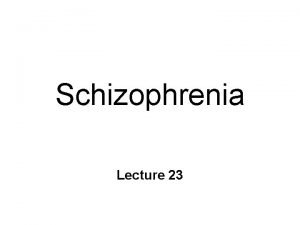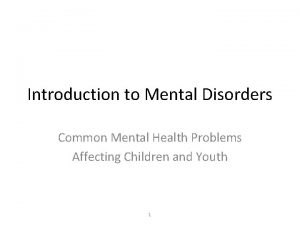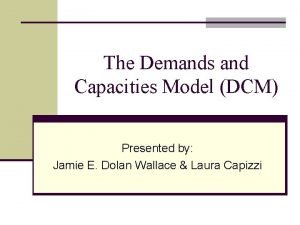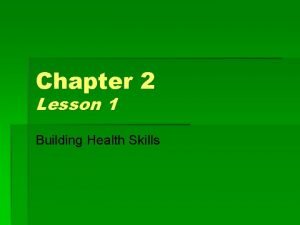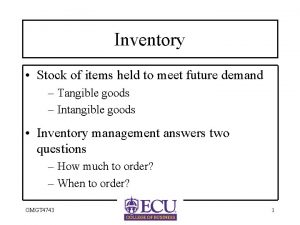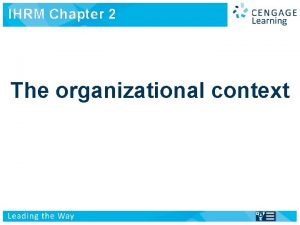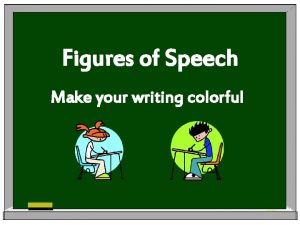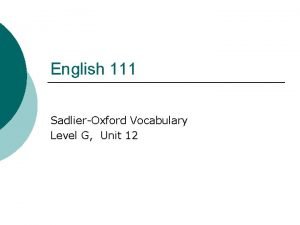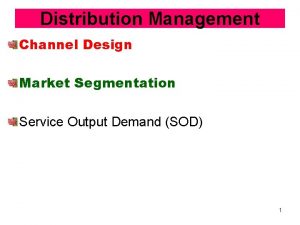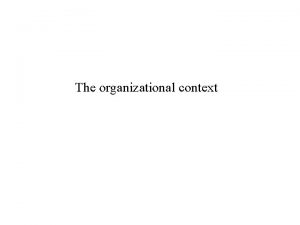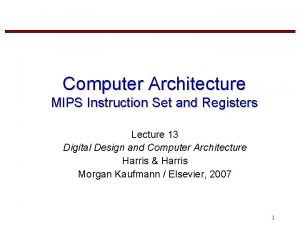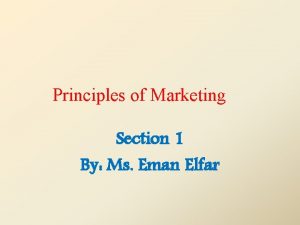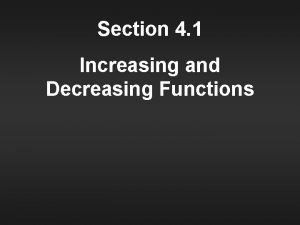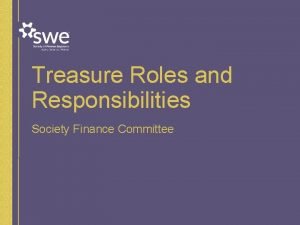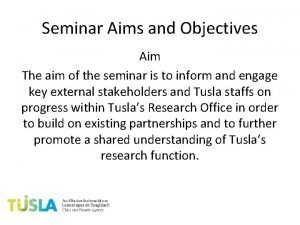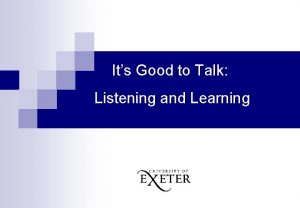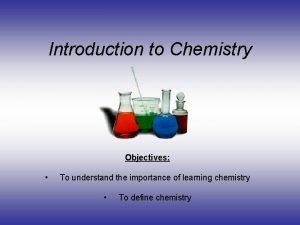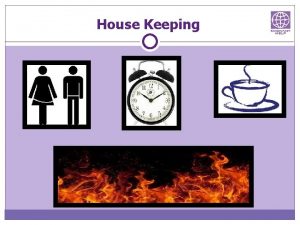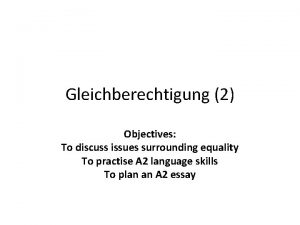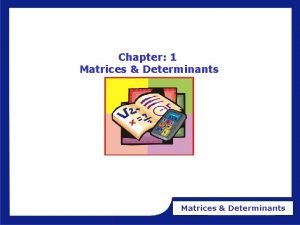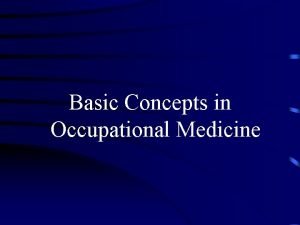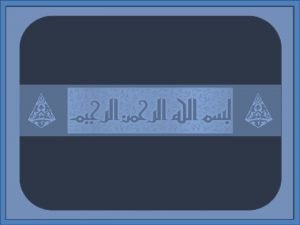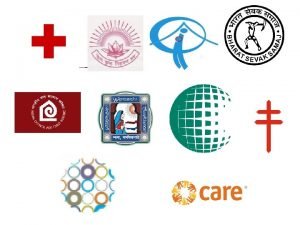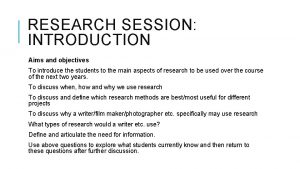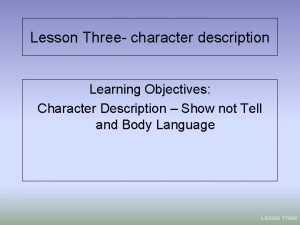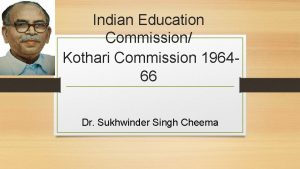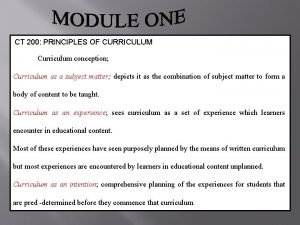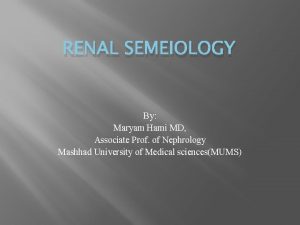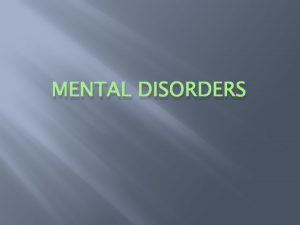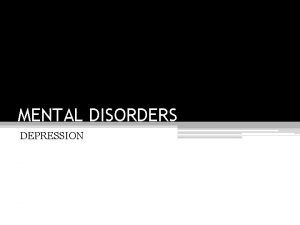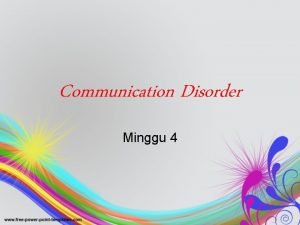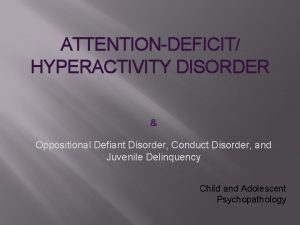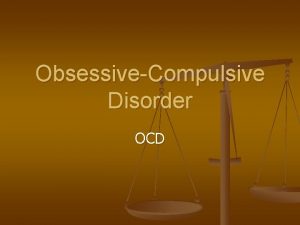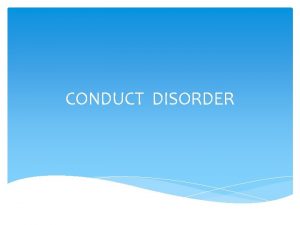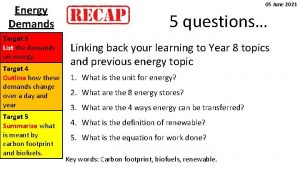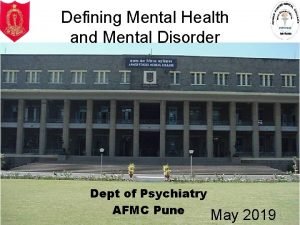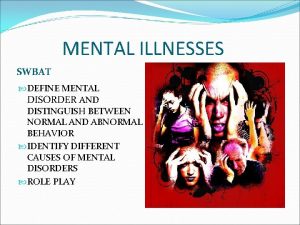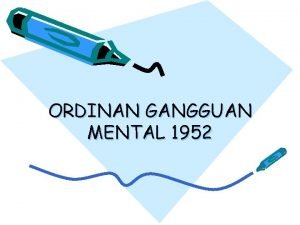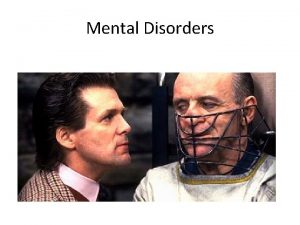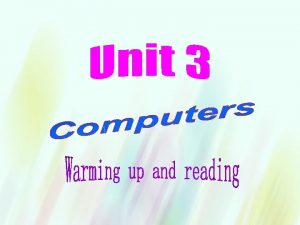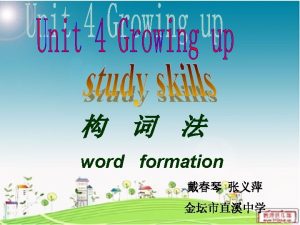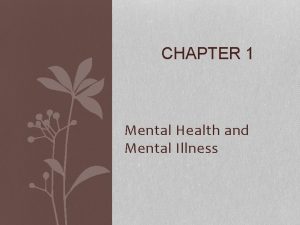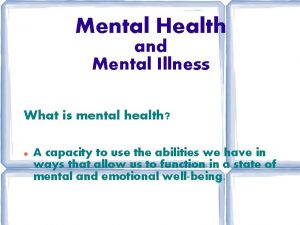Semeiology of mental disorder Aims and demands To




















































- Slides: 52

Semeiology of mental disorder

Aims and demands ü To master the names, the concepts and the meanings of the symptoms of mental disorder. ü To master the distinctions between the confusing symptoms.

Common Psychiatric Symptom Ø Disorders of sensations and perceptions Ø Disorders of thought Ø Disorders of mood Ø Disorders of consciousness Ø Disorders of attention and concentration Ø Disorders of memory Ø Disorders of intellectual performance Ø Insight

Sensations, perceptions and imagery • Sensation: a reflection to individual attributes of things that produced by a sense organ under objective stimulus. • Perception: a whole reflection that various attributes are synthesized in brain. • Imagery: is an experience within the mind, usually without the feeling of reality that is part of perception.

Disorders of sensation • Hyperesthesia • Hypoesthesia and anesthesia • Senestopathias

Disturbance of perception • Illusion: a distorted perception of the external objective stimuli. • Hallucination: perception without an object, or as the appearance of an individual thing in the world without any corresponding material event.

Classification of Hallucination According to the involved organs According to the feeling source: • auditory hallucination • visual hallucination • olfactory hallucination • gustatory hallucination • bodily, tactile hallucinations • visceral hallucination • Genuine hallucinations: Hallucinatory figure is vividly existing in external space and experienced by sensory organs. • Pseudohallucinations: Hallucinatory figure is not so vivid, come from the subjective space, not experiencing by sensory organs.

Disorders of thought ü Disturbances of the speed and interruptions in the flow of thought ü Disorders of the form of thought ü Disorder of the content of thought ü Overvalued idea

Disturbances of the speed and interruptions in the flow of thought u Poverty of thought u Inhibition of thought u Thought blocking u Loosening of associations u Flight of thought u Splitting of thought u Circumstantiality

Flight of thought • Known as the fleet of concept. The association speeds up, manifolds, the content is abundant and vividly. • The patients speak rapidly, and state that their brain response agility, topic of speaking is liable to change with the surrounding stimulus; • Mostly occur in mania.

Inhibition of thought • Inhibition of association, low speed of speaking, the amount of speech decrease, low voice, slow response. • People feel themselves difficulty of association, become stupid, and their brains “dull”. • Mostly found in depression.

Poverty of thought • The quantity of association decreases, poverty of concept and glossary. • Experiencing empty of brain, nothing existing. • Patients are silent, wordless, and void. The severe ones are similar to idiots. • It can be found in schizophrenia, organic mental disorders of brain and mental retardation.

Looseness of association • Disturbance of objective, coherence and logicality of thinking in consciousness state. looseness of content, lack of topic or main idea. • Patient’s reply to the question is not to the point, so that the interviewers find it difficult to talk with the patients.

Splitting of thought • The splitting of associations of concepts, internal connection lack between associated concepts, or no connection between sentences, or even words (called word salad). • Mostly found in schizophrenia.

Circumstantiality • Twist and turns of thinking activities, over abundance of the meaningless associations, too detailed and unnecessary describe, yet in the end coming back to the point. • Found in epilepsy, organic and geriatric mental disorder.

Blocking of thought • The process of thinking intermits suddenly, while the patient has no consciousness disorder or external disturbance. • The patient stops talking suddenly, and speak again after a while, but the content is not the previous topic. • It can be also called thought deprivation.

Disorders of the form of thought Coherent disorder Logical disorder u thought insertion u neologism u thought hearing u Pathological Symbolic thought u diffusion of thought u paralogism thinking u obsessive idea

Thought insertion • Patients believe some of their thought are not their own but have been implanted compulsively by an outside agency. • If the pointless thoughts emerged compulsively by large amount style, then called forced thoughts. • This symptom usually emerge suddenly and vanish promptly.

Thought hearing • Patients believe that their thought are turning into voice, so others and themselves can hear it. • Frequently occur in schizophrenia.

Diffusion of thought • Patients believe that their thoughts are known by all as soon as they think, and that they share their thought with other people and have no privacy. • If patients believe that their thought be broadcasted known by others, it is called thought broadcasting. • It’s a diagnostic significance for schizophrenia.

Neologism • Mingling, condensing of concept and piecing together of unrelated concept. • Patient invents some new symbols, graphs, words or language and endow them with special concept. • Mostly found in hebephrenic schizophrenia.

Pathological Symbolic thought • Concept conversion, substituting an abstract concept for a concrete one. • e. g. a buddhist consider the sunshine as the light of Buddha

Paralogism Thinking • Main characteristic is the absence of logicality in reasoning, neither premise nor basis, or inversion of cause and effect. • It can be seen in schizophrenia and paranoid psychosis.

Obsessive idea • Repeated emergence of the same concept or thought obsessively. The patient knows it unnecessary but can’t get rid of. • Predominated by obsessive thoughts, ideas, recall or image, opposite thoughts, obsessive rumination, obsessive suspicion, obsessive fear of loss of self-control, usually combining with behaviors.

Disorder of the content of thought u Delusion concept u Characteristics u Main categories of delusion

Delusion concept A firmly held false belief or idea based on a pathological process, despite the abundant contradictory evidences, or a morbid reasoning and judgement.

Characteristics • Content doesn’t agree with fact, no objective basis, but firmly held by the patient. • Content involves the patient self, and concerns his benefits. • Delusion is individual-specific or single to patient. • Contents vary from the cultural background and individual experience, usually have the characteristics of the times.

Main categories of delusions • It can be classified into primary and secondary delusion by its originality and relation with other mental activity. • It can be also categorized into systematic and non-systematic delusion according to the structure of the delusion. • It is mostly classified according to the content.

Primary delusions • Appearing suddenly and with full conviction but without any mental events lead up to it. • It is the characteristic symptom of schizophrenia, and is very helpful for the diagnoses.

Secondary delusions • The delusion derives from other morbid mental basis, or other delusions. • Found in many mental diseases.

Systematic delusions • Delusional content interrelate with each other, and has a strict structure and a good logicality. • or else, it is non-systematic delusions.

Delusions according to the content. p p p p p delusion of persecution delusion of reference delusion of physical influence grandiose delusion of guilt hypochondriacal delusion of love delusion of jealousy experience of being revealed

Delusions of persecution • Believing firmly himself to be tracked, watched, slandered , isolated, etc. • Under the control of the delusions, the patient may refuse to eat or accuse, self-defend, escape, suicide, or injure others. • Mostly found in schizophrenia and paranoid psychosis.

Delusions of reference • The patient concerns with the idea that objects, events, or people have a personal significance for himself. Commonly accompanying with persecutory delusions. • Mostly found in schizophrenia.

Delusions of physical influence • Also called delusions of control. The patients believes that their thoughts, feelings, and behaviors are under the control of some outside agency or forces; • The symptom strongly suggests schizophrenia.

Grandiose delusions • Or expensive delusions, the patient thinks himself having extraordinarily ability or wisdom, sovereign right or status, wealth or invention , or is the descendant of some celebrity. • Can be seen in mania, schizophrenia, and some organic psychosis.

Delusions of guilt • Patient believes firmly that he commits severe errors or irremissible guilt, and deserves rigorous punishment without any reason, and just sits still waiting for death or refuses any food, or may suicide; demands punish for atonement. • The symptom strongly suggests depression, also schizophrenia.

Hypochondriacal delusions • Patient believes firmly that he suffers some serious or incurable diseases, then seek treatment everywhere, even a series of careful examination and medical test can’t correct it. • Found in schizophrenia, menopausal or geriatric mental disorders, etc.

Delusions of love • Believes himself to be deeply loved by opposite sex without any evidence, adopts corresponding behaviors to approach the opposite side, even received refusal, so, it is not simple one-sided love.

Delusions of jealousy • Believes his spouse not to be loyal to him and have another lover, therefore tracks and watches his spouse’s daily activity or checks spouse’s personal matters to seek the evidences of cuckoldry. • May found in male schizophrenia, or climacteric mental disorder.

Experiences of being revealed • Believes that his unspoken thoughts are known to others, but can’t confirm how be known by others. • Strongly suggests schizophrenia.

Overvalued idea • A unilateral and extreme false idea that occupies a leading position and commonly has some factual basis, and with strong emotional color, obviously affecting behaviors and other mentality. • Mostly find in personality disorder and psychological disorder.

Disorders of mood • Mood can be considered as a quality of the state of mind which is more lasting than affects and feelings • Mood can be abnormal in several ways: ü sad or anxious in depressive disorders; ü euphoric in mania; ü irritated in mania or agitated depression; ü dysphoric in depression ; ü morose in chronic depressed states.

Disorders of consciousness Ø Disorientation: time, place, or person. Ø Twilight state: a well-defined interruption of the continuity of consciousness. Consciousness is clouded and sometimes narrowed. The patient is able to perform certain actions, such as dressing, driving, or walking around. Subsequently, there is amnesia for this state. Ø Oneiroid state: the patient experiences narrowing of consciousness together with multiple scenic hallucinations. Ø Narrowing of consciousness: the awareness of a person's environment is restricted, for example owing to an abnormal affective or delusional state.

Disorders of attention and concentration Ø Attention and concentration both mean the directing of mental activities towards a particular object. Ø Little difference: attention is associated with present alertness, and concentration with longer-lasting achievement and performance.

Disorders of memory ü Memory may be differentiated into short-term or recent memory and longterm or remote memory. ü Short-term memory reflects new learning. Long-term memory is usually associated with earlier data or other information that has been stored for months or years. ü recent memory is usually impaired earlier than remote memory.

Ø Amnesia: a period of time which cannot be recalled and it may be global or partial. • With regard to time it may be retrograde—an expression derived from the idea that one is looking backwards from an event (such as brain trauma or electroconvulsive therapy) to find the period before the event to be deleted. Correspondingly, anterograde amnesia means a period of deleted memory after an event. • focal lesions in the hippocampus seem to affect remote memory less than recent memory, whereas diffuse brain disease often affects both.

Ø Confabulations: inventions which substitute for missing contents in gaps of memory; the patient is not aware that they are not true memories. Ø False memories: an erroneous feeling of familiarity with, for example, a person or a room. It may occur in temporal lobe epilepsy, but it is not specific for that disorder.

Disorders of intellectual performance Ø Intelligence: the capacity to solve problems, to cope with new situations, to acquire skills through learning and experiences, to establish logical deductions, and to form abstract concepts. Ø It canbe measured by intelligence quotient (IQ)

• If the development of intellectual performance does not reach an IQ level of 70, the condition is called ‘mental retardation'. • Four levels are recognized in ICD-10 for mental retardation: • mild (IQ 50– 69) • moderate (IQ 35– 49) • severe (IQ 20– 34) • profound (IQ below 20).

Insight ü The clinical assessment of a patient's capacity to understand the nature, significance, and severity of his or her own illness. ü It is composed of three overlapping dimensions: the ability to relabel unusual mental events as pathological, the recognition that one has mental illness, and compliance with treatment ü In clinical practice, the patient's awareness of the presence of illness (insight) is related to the compliance with prescribed treatment, so it is considerable significance.

 Somatic vs factitious
Somatic vs factitious Axis 1 and axis 2 disorders
Axis 1 and axis 2 disorders Mental disorder definition
Mental disorder definition Mental disorder definition
Mental disorder definition Causes of mental disorder
Causes of mental disorder Chapter 20 mental health and mental illness
Chapter 20 mental health and mental illness Demands and capacities model
Demands and capacities model Needs wants and demands
Needs wants and demands Pegawai pemasaran
Pegawai pemasaran Building health skills chapter 1
Building health skills chapter 1 Stress management jeopardy
Stress management jeopardy Principles of training individuality
Principles of training individuality A stock of items held to meet future demands.
A stock of items held to meet future demands. The path to global status in ihrm
The path to global status in ihrm Don't delay dawns disarming display. dusk demands daylight
Don't delay dawns disarming display. dusk demands daylight Level f unit 12
Level f unit 12 Service output demand
Service output demand Paralinguistic demands
Paralinguistic demands Management demands of international growth
Management demands of international growth Good design demands good compromises
Good design demands good compromises When backed by buying power wants become
When backed by buying power wants become Disadvantages of instructional objectives
Disadvantages of instructional objectives Classify each decreasing function as having a slope
Classify each decreasing function as having a slope Aims and objectives of reading
Aims and objectives of reading Main objectives of unemployment
Main objectives of unemployment Duties of a treasure
Duties of a treasure Objectives for seminar
Objectives for seminar No but why
No but why Objective of discipline
Objective of discipline Aims and objectives of listening skills
Aims and objectives of listening skills Introduction to chemistry
Introduction to chemistry What are the objectives of interior design
What are the objectives of interior design Aims and objectives of human trafficking
Aims and objectives of human trafficking Aims and ambitions vokabeln
Aims and ambitions vokabeln Gs god
Gs god Objective on pollution
Objective on pollution Area of triangle determinant
Area of triangle determinant Aims and objectives of occupational health
Aims and objectives of occupational health Aims of air pollution
Aims of air pollution Aims and objectives creation of pakistan
Aims and objectives creation of pakistan Aims and objectives of economics
Aims and objectives of economics Functions of voluntary health agencies
Functions of voluntary health agencies Aims of physical education
Aims of physical education Aims and objectives of technology
Aims and objectives of technology Introduction aims and objectives
Introduction aims and objectives Objective of red cross society
Objective of red cross society Aims and objectives of physical education in greece
Aims and objectives of physical education in greece Character objectives
Character objectives Kothari commission report
Kothari commission report 0470 syllabus
0470 syllabus Objective of hand washing
Objective of hand washing Difference between centralized and decentralized curriculum
Difference between centralized and decentralized curriculum History of community development in tanzania
History of community development in tanzania


